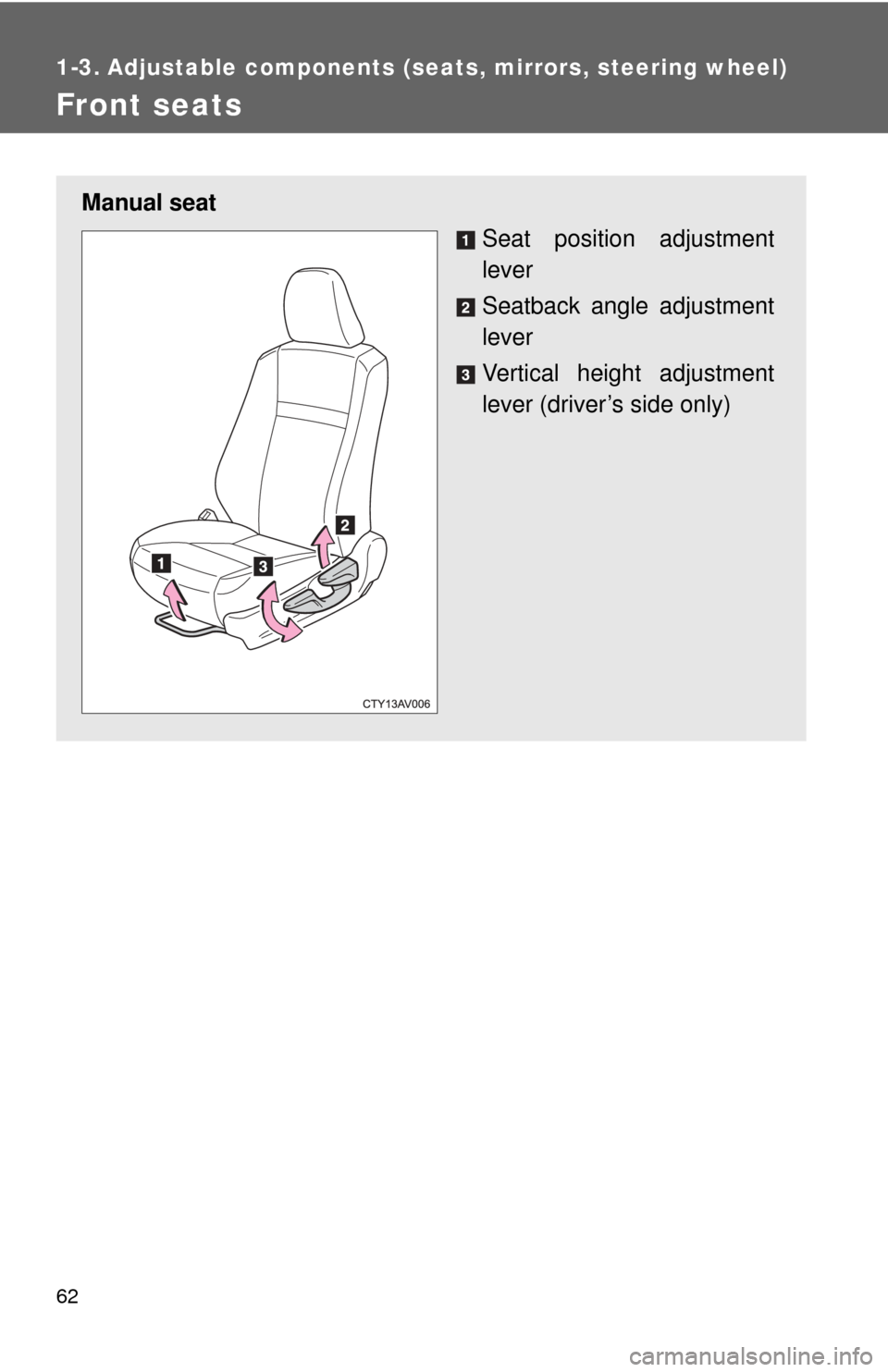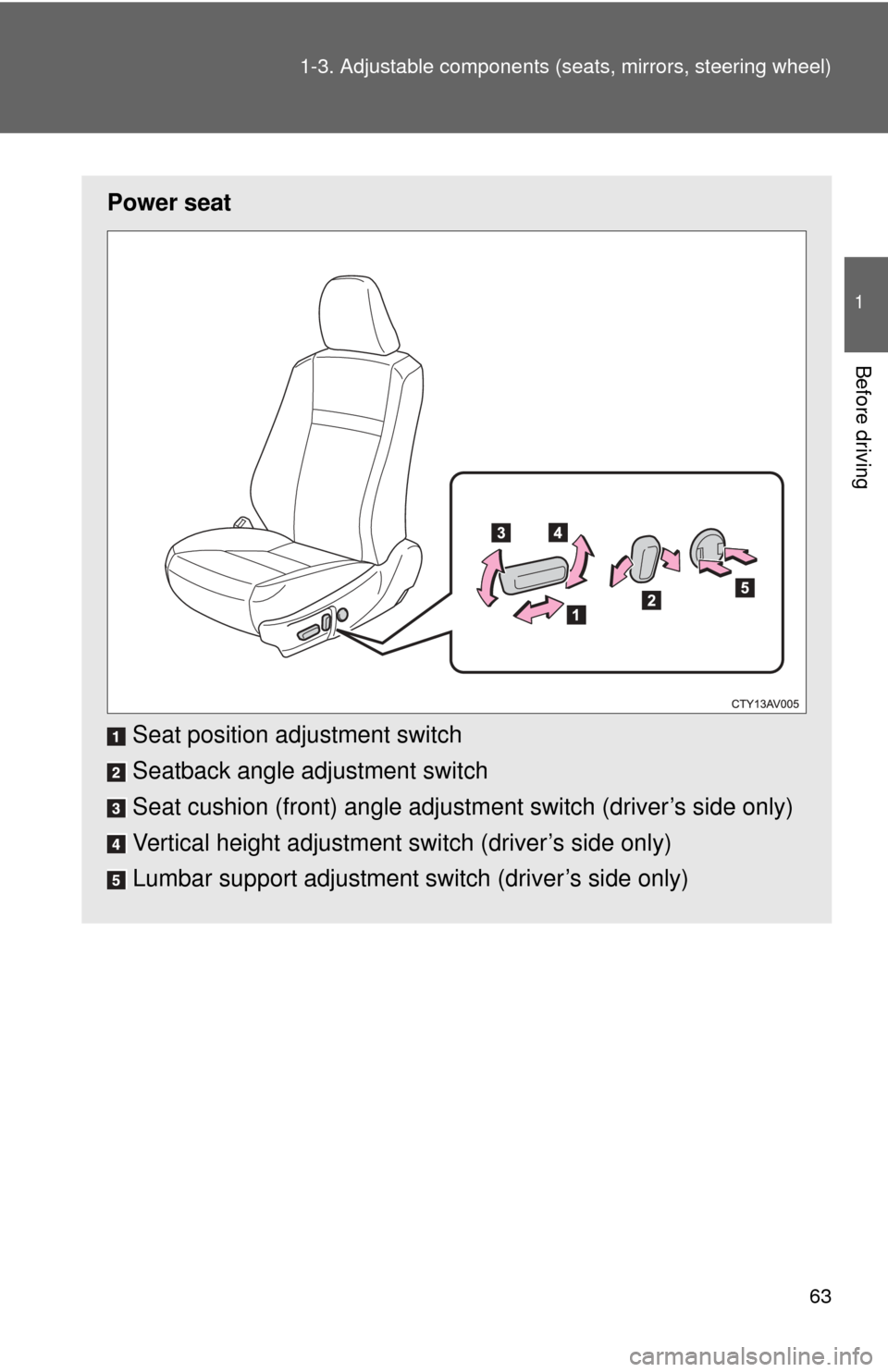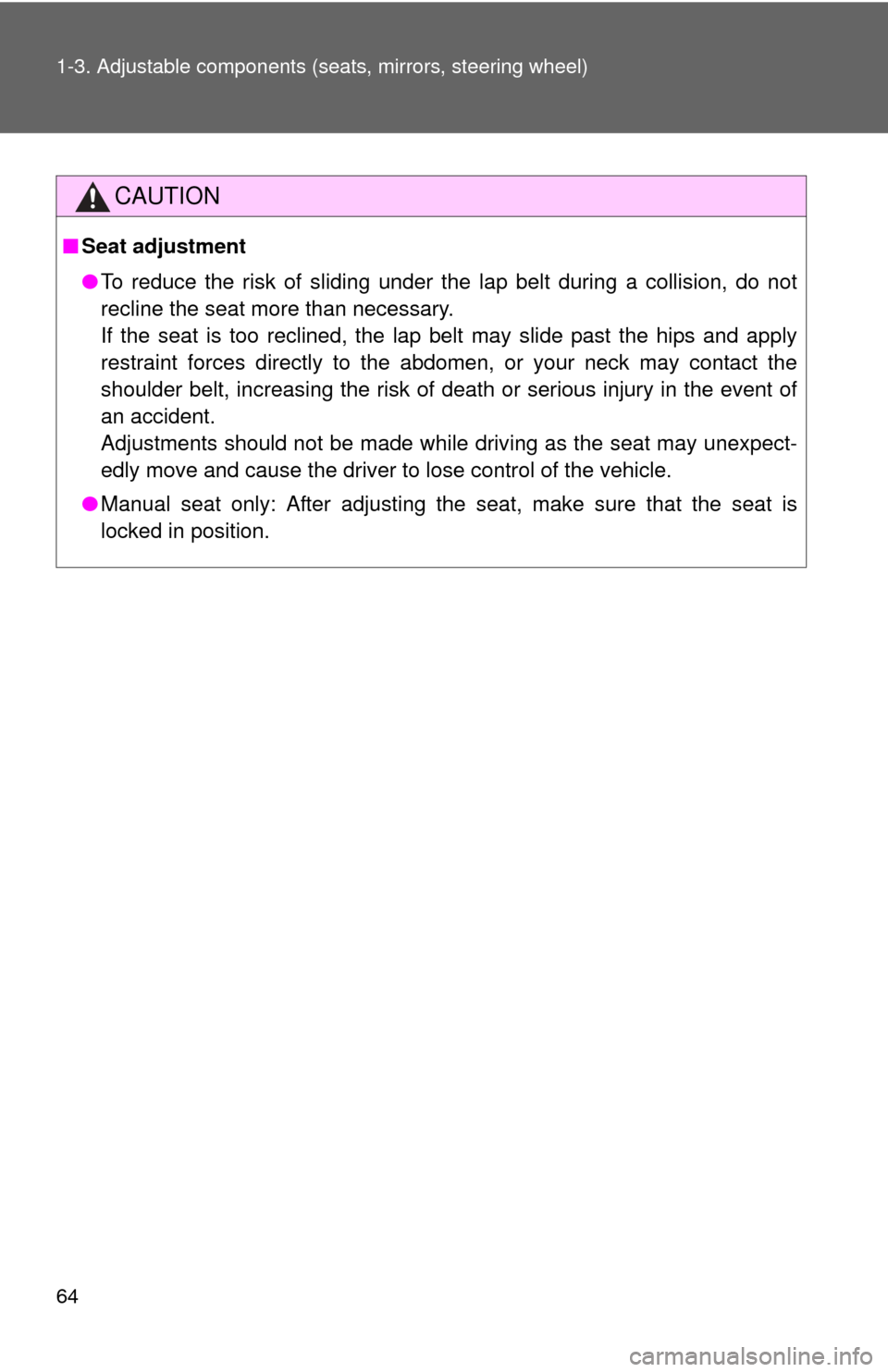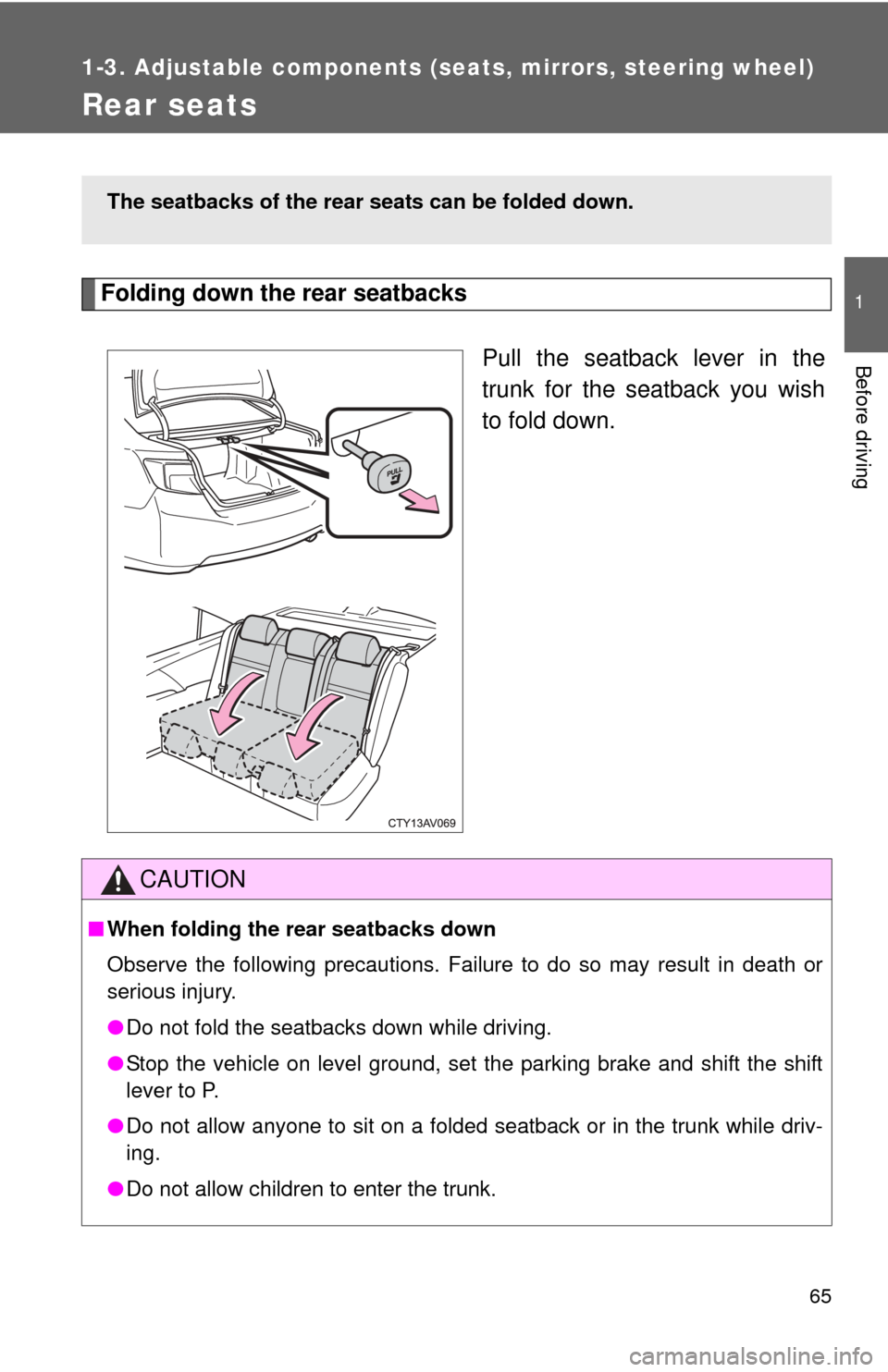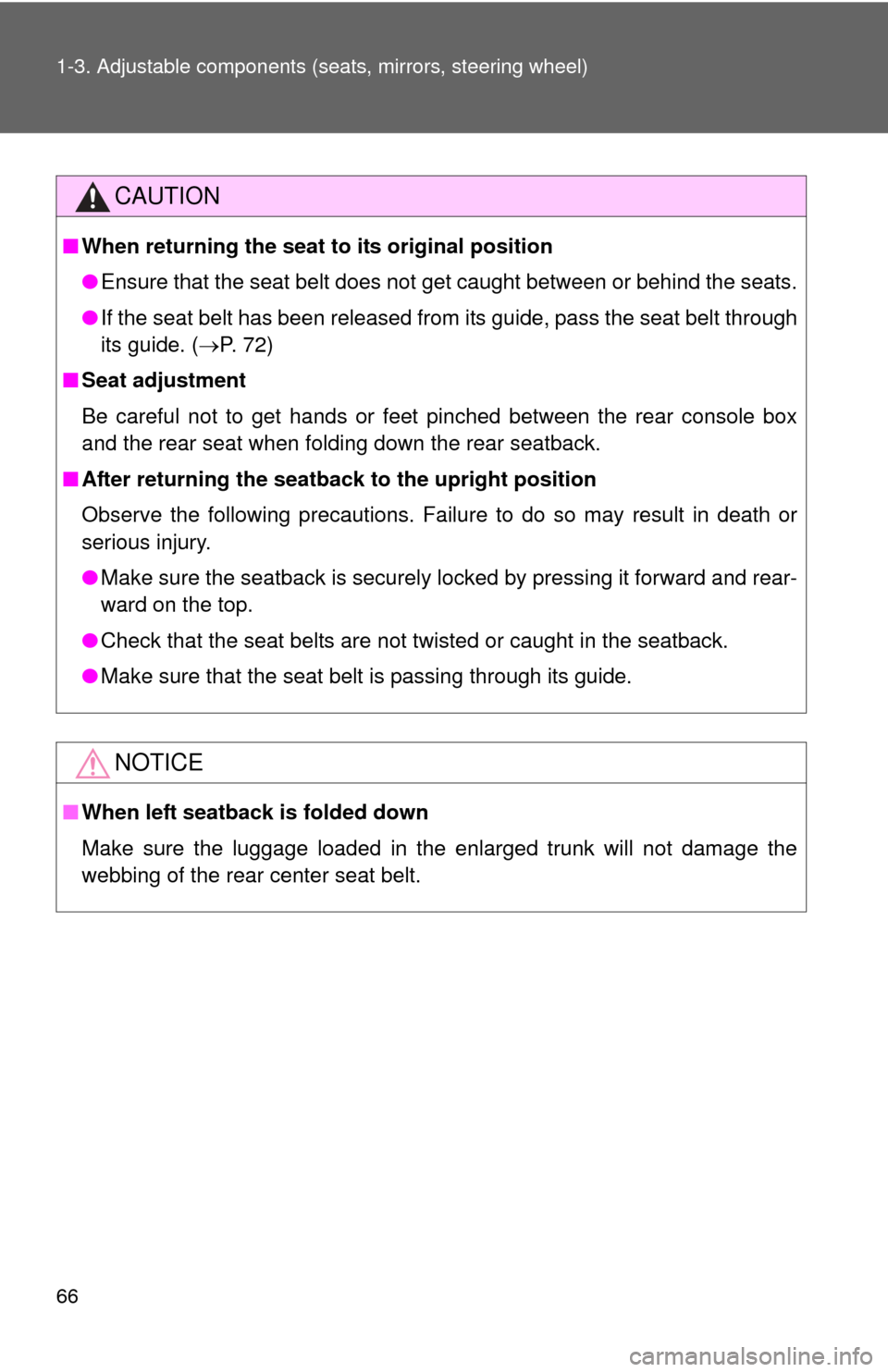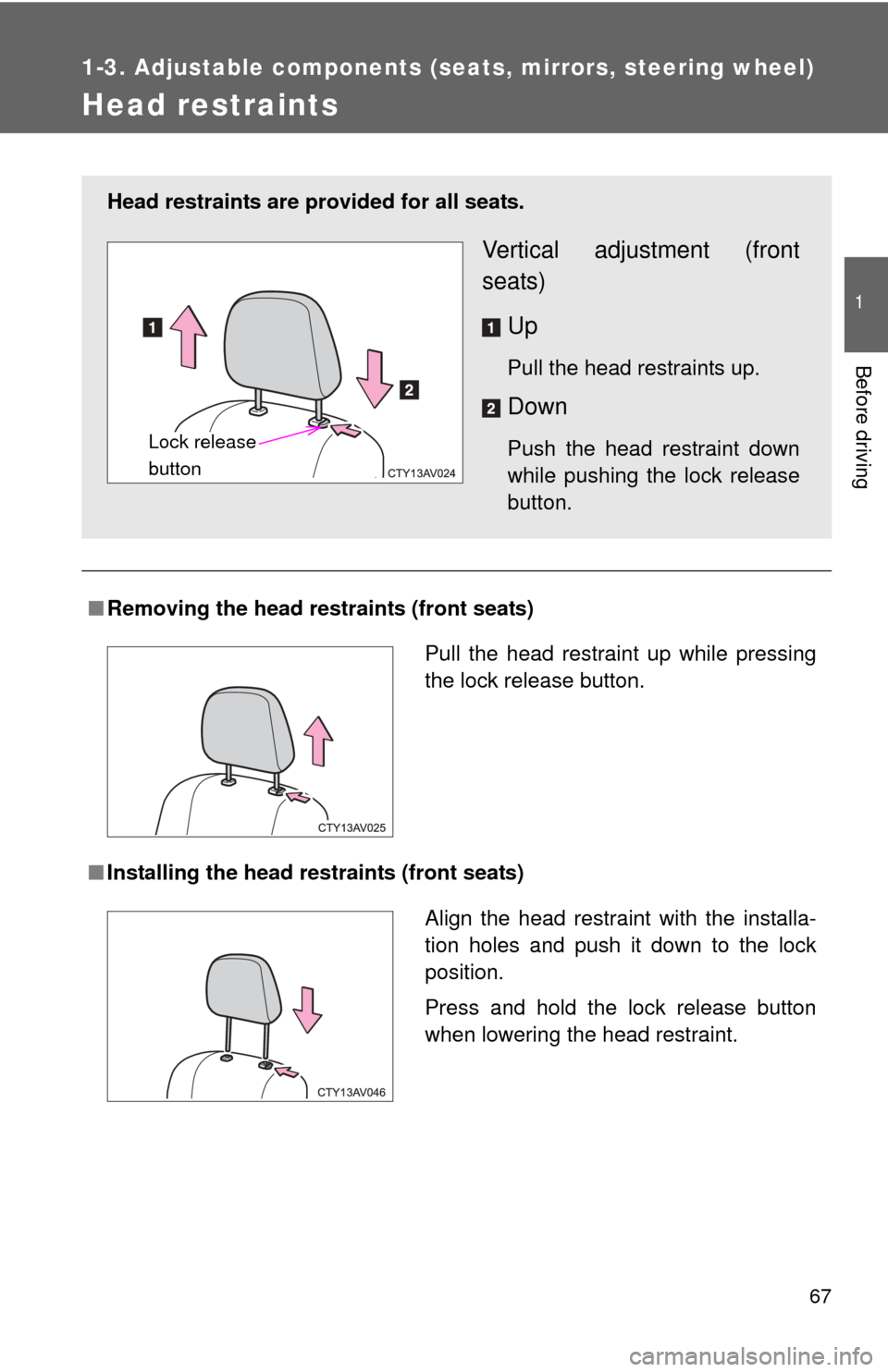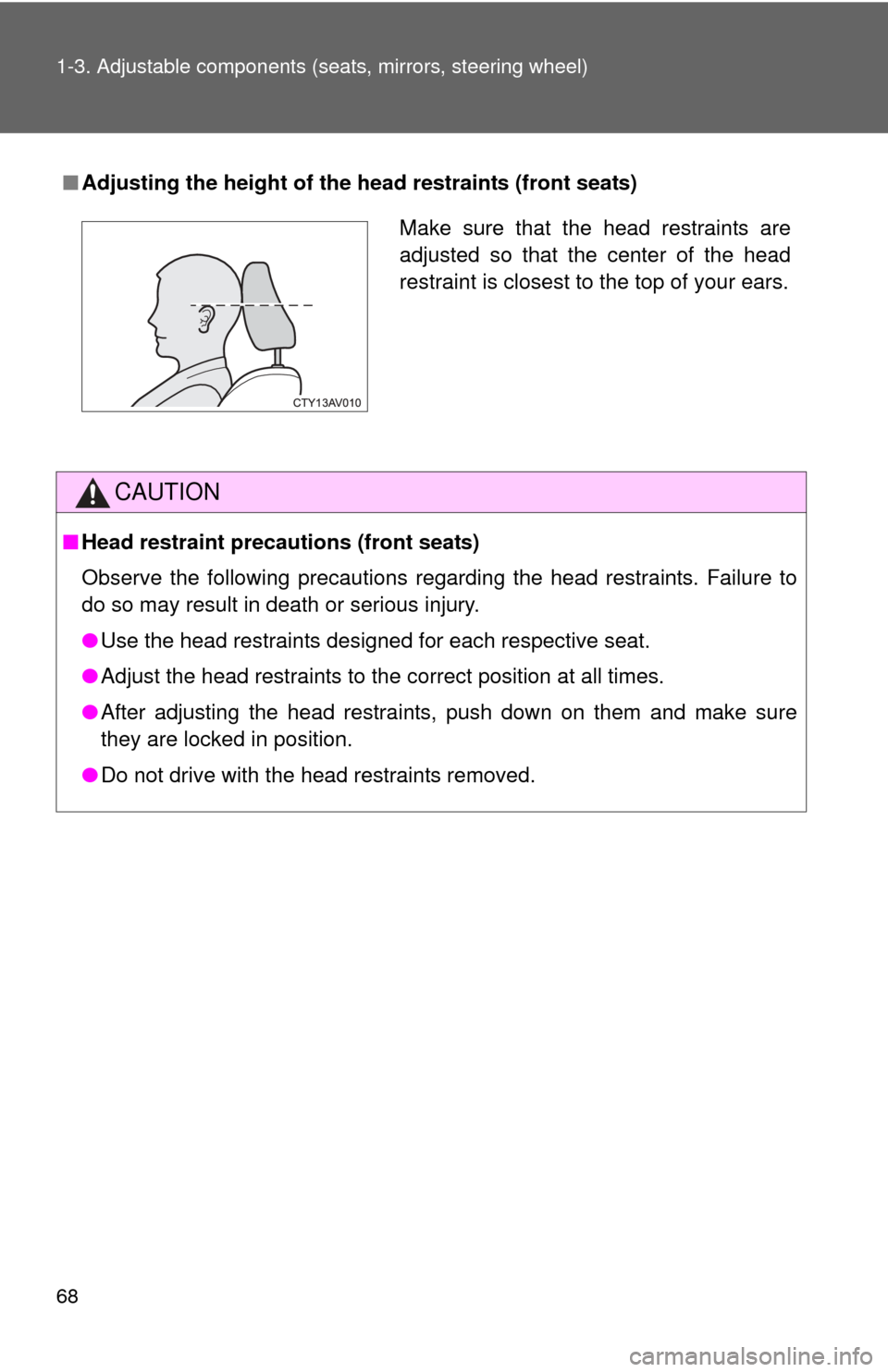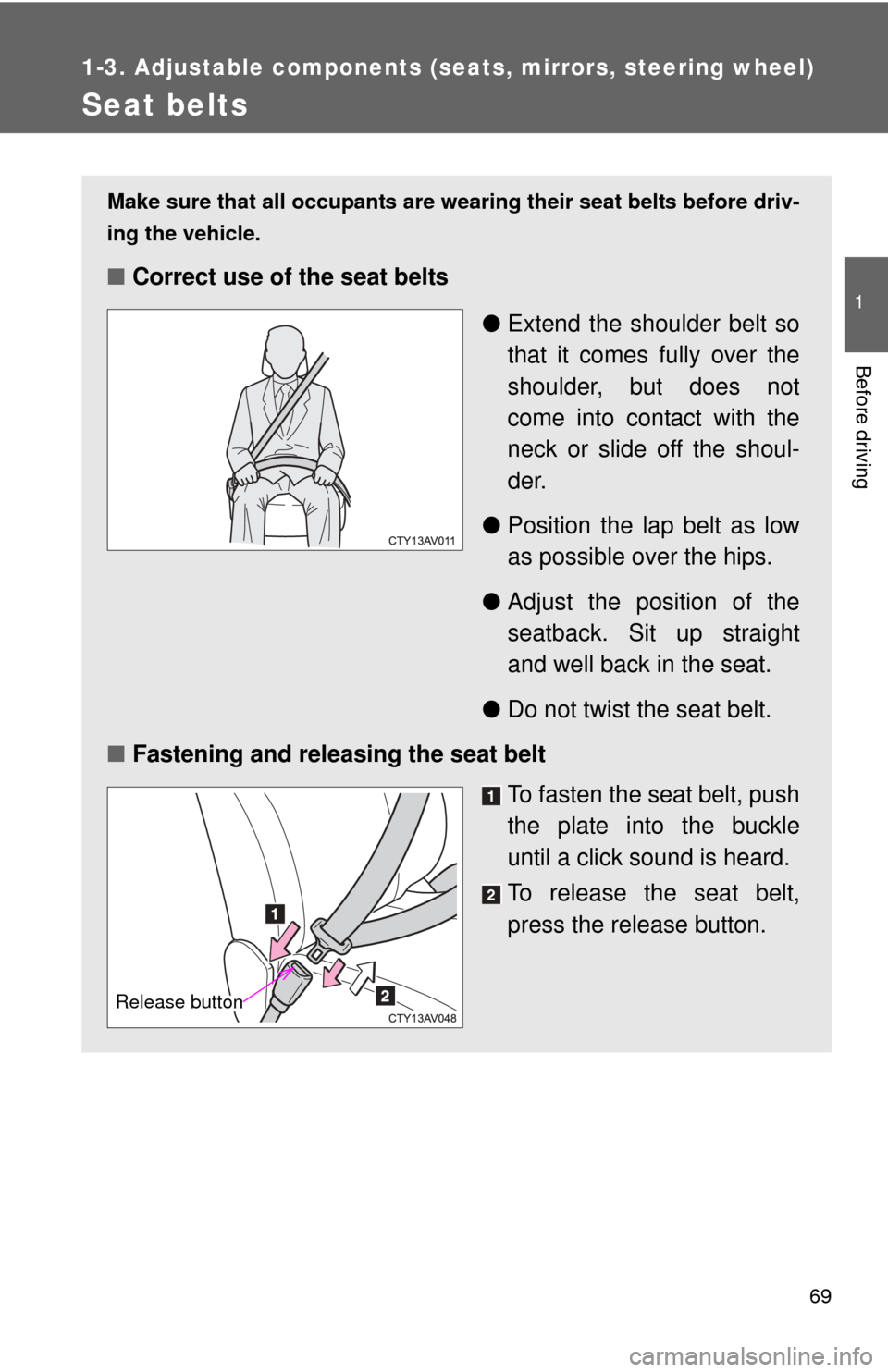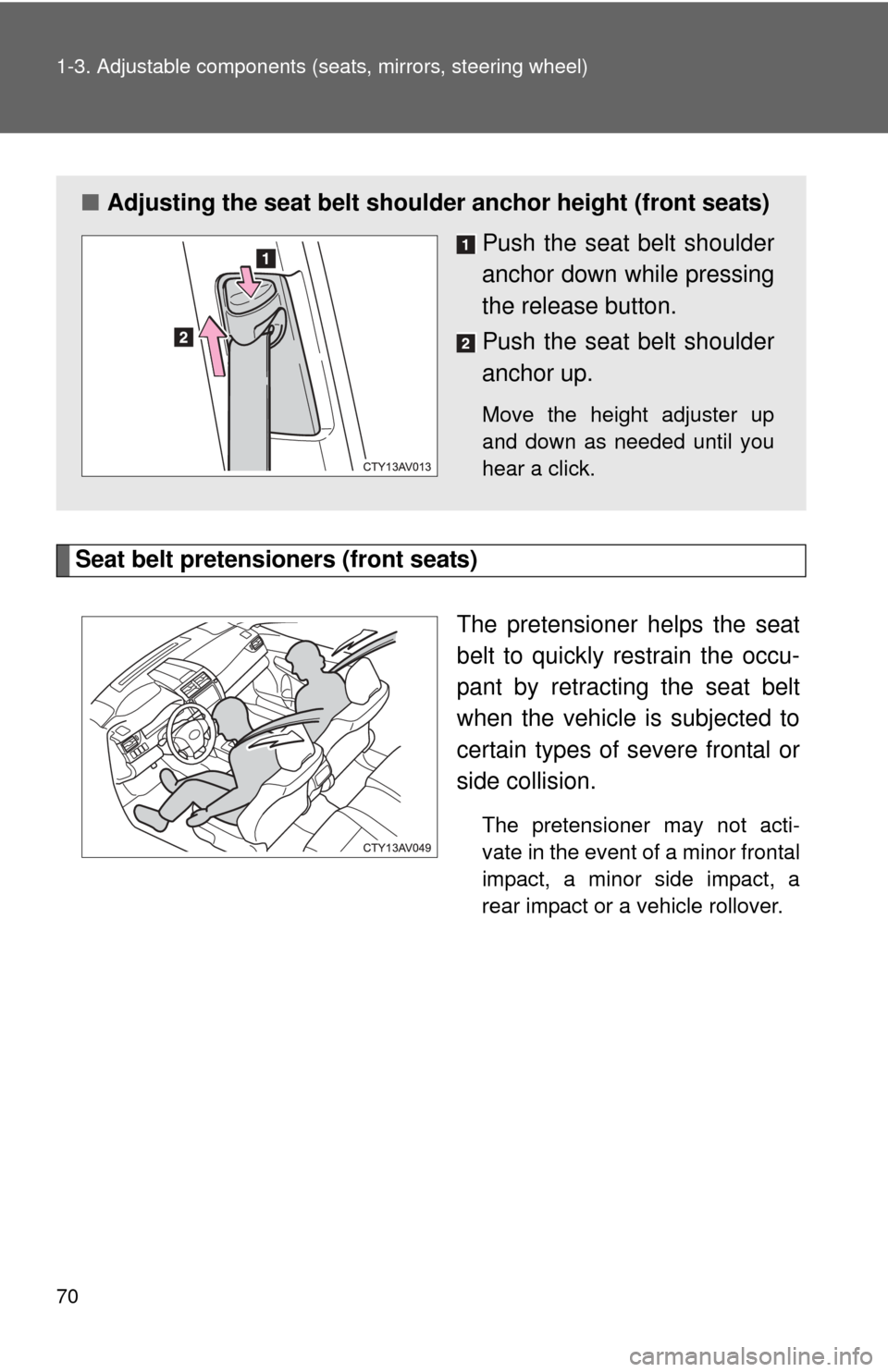TOYOTA CAMRY 2013 XV50 / 9.G Repair Manual
CAMRY 2013 XV50 / 9.G
TOYOTA
TOYOTA
https://www.carmanualsonline.info/img/14/6242/w960_6242-0.png
TOYOTA CAMRY 2013 XV50 / 9.G Repair Manual
Trending: service indicator, transmission fluid, spare tire location, coolant capacity, diagram, USB port, odometer
Page 61 of 540
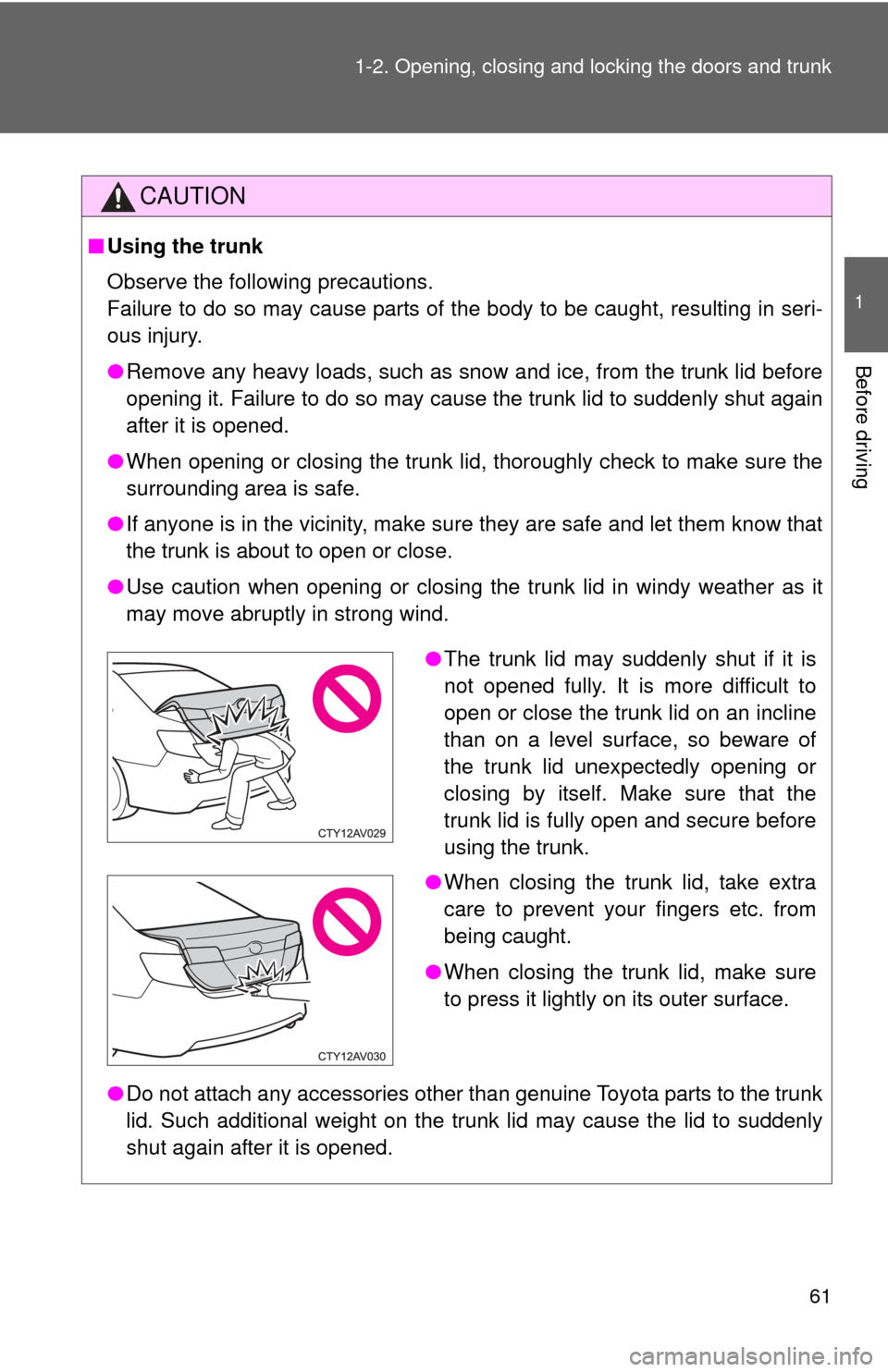
61
1-2. Opening, closing and locking the doors and trunk
1
Before driving
CAUTION
■
Using the trunk
Observe the following precautions.
Failure to do so may cause parts of the body to be caught, resulting in seri-
ous injury.
●Remove any heavy loads, such as snow and ice, from the trunk lid before
opening it. Failure to do so may cause the trunk lid to suddenly shut again
after it is opened.
● When opening or closing the trunk lid, thoroughly check to make sure the
surrounding area is safe.
● If anyone is in the vicinity, make sure they are safe and let them know that
the trunk is about to open or close.
● Use caution when opening or closing the trunk lid in windy weather as it
may move abruptly in strong wind.
● Do not attach any accessories other than genuine Toyota parts to the trunk
lid. Such additional weight on the trunk lid may cause the lid to suddenly
shut again after it is opened.
●The trunk lid may suddenly shut if it is
not opened fully. It is more difficult to
open or close the trunk lid on an incline
than on a level surface, so beware of
the trunk lid unexpectedly opening or
closing by itself. Make sure that the
trunk lid is fully open and secure before
using the trunk.
● When closing the trunk lid, take extra
care to prevent your fingers etc. from
being caught.
● When closing the trunk lid, make sure
to press it lightly on its outer surface.
Page 62 of 540
62
1-3. Adjustable components (seats, mirrors, steering wheel)
Front seats
Manual seat
Seat position adjustment
lever
Seatback angle adjustment
lever
Vertical height adjustment
lever (driver’s side only)
Page 63 of 540
63
1-3. Adjustable components (s
eats, mirrors, steering wheel)
1
Before driving
Power seat
Seat position adjustment switch
Seatback angle adjustment switch
Seat cushion (front) angle adjustment switch (driver’s side only)
Vertical height adjustment switch (driver’s side only)
Lumbar support adjustment switch (driver’s side only)
Page 64 of 540
64 1-3. Adjustable components (seats, mirrors, steering wheel)
CAUTION
■Seat adjustment
●To reduce the risk of sliding under the lap belt during a collision, do not
recline the seat more than necessary.
If the seat is too reclined, the lap belt may slide past the hips and apply
restraint forces directly to the abdomen, or your neck may contact the
shoulder belt, increasing the risk of death or serious injury in the event of
an accident.
Adjustments should not be made while driving as the seat may unexpect-
edly move and cause the driver to lose control of the vehicle.
● Manual seat only: After adjusting the seat, make sure that the seat is
locked in position.
Page 65 of 540
65
1
1-3. Adjustable components (seats, mirrors, steering wheel)
Before driving
Rear seats
Folding down the rear seatbacksPull the seatback lever in the
trunk for the seatback you wish
to fold down.
The seatbacks of the rear seats can be folded down.
CAUTION
■When folding the rear seatbacks down
Observe the following precautions. Failure to do so may result in death or
serious injury.
●Do not fold the seatbacks down while driving.
● Stop the vehicle on level ground, set the parking brake and shift the shift
lever to P.
● Do not allow anyone to sit on a folded seatback or in the trunk while driv-
ing.
● Do not allow children to enter the trunk.
Page 66 of 540
66 1-3. Adjustable components (seats, mirrors, steering wheel)
CAUTION
■When returning the seat to its original position
●Ensure that the seat belt does not get caught between or behind the seats.
● If the seat belt has been released from its guide, pass the seat belt through
its guide. ( P. 72)
■ Seat adjustment
Be careful not to get hands or feet pinched between the rear console box
and the rear seat when folding down the rear seatback.
■ After returning the seatback to the upright position
Observe the following precautions. Failure to do so may result in death or
serious injury.
● Make sure the seatback is securely locked by pressing it forward and rear-
ward on the top.
● Check that the seat belts are not twisted or caught in the seatback.
● Make sure that the seat belt is passing through its guide.
NOTICE
■When left seatback is folded down
Make sure the luggage loaded in the enlarged trunk will not damage the
webbing of the rear center seat belt.
Page 67 of 540
67
1
1-3. Adjustable components (seats, mirrors, steering wheel)
Before driving
Head restraints
■Removing the head restraints (front seats)
■ Installing the head r estraints (front seats)
Head restraints are provided for all seats.
Vertical adjustment (front
seats)
Up
Pull the head restraints up.
Down
Push the head restraint down
while pushing the lock release
button. Lock release
button
Pull the head restraint up while pressing
the lock release button.
Align the head restraint with the installa-
tion holes and push it down to the lock
position.
Press and hold the lock release button
when lowering the head restraint.
Page 68 of 540
68 1-3. Adjustable components (seats, mirrors, steering wheel)
■Adjusting the height of the head restraints (front seats)
CAUTION
■Head restraint pr ecautions (front seats)
Observe the following precautions regarding the head restraints. Failure to
do so may result in death or serious injury.
● Use the head restraints designed for each respective seat.
● Adjust the head restraints to the correct position at all times.
● After adjusting the head restraints, push down on them and make sure
they are locked in position.
● Do not drive with the head restraints removed.
Make sure that the head restraints are
adjusted so that the center of the head
restraint is closest to the top of your ears.
Page 69 of 540
69
1
1-3. Adjustable components (seats, mirrors, steering wheel)
Before driving
Seat belts
Make sure that all occupants are wearing their seat belts before driv-
ing the vehicle.
■Correct use of the seat belts
●Extend the shoulder belt so
that it comes fully over the
shoulder, but does not
come into contact with the
neck or slide off the shoul-
der.
● Position the lap belt as low
as possible over the hips.
● Adjust the position of the
seatback. Sit up straight
and well back in the seat.
● Do not twist the seat belt.
■ Fastening and releasing the seat belt
To fasten the seat belt, push
the plate into the buckle
until a click sound is heard.
To release the seat belt,
press the release button.
Release button
Page 70 of 540
70 1-3. Adjustable components (seats, mirrors, steering wheel)
Seat belt pretensioners (front seats)
The pretensioner helps the seat
belt to quickly restrain the occu-
pant by retracting the seat belt
when the vehicle is subjected to
certain types of severe frontal or
side collision.
The pretensioner may not acti-
vate in the event of a minor frontal
impact, a minor side impact, a
rear impact or a vehicle rollover.
■Adjusting the seat belt shoulde r anchor height (front seats)
Push the seat belt shoulder
anchor down while pressing
the release button.
Push the seat belt shoulder
anchor up.
Move the height adjuster up
and down as needed until you
hear a click.
Trending: transmission, start stop button, Indicator, clock, Headlight, tire size, navigation

